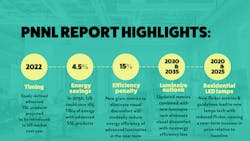Pacific Northwest National Laboratory (PNNL) has published the results of a US Department of Energy (DOE)-funded study intended to project the impact on planned solid-state lighting (SSL) technology innovations. The research focused on improvements in LED lighting that could be driven by PNNL technology research initiatives. The study reveals significant energy savings attributed to coming advanced SSL products even if some of the advancements demand modest tradeoffs in energy efficiency.
The DOE’s PNNL has participated in a number of studies projecting energy savings attributable to a complete transition to LED-based lighting in common general-illumination applications. Indeed, the latest such study published in early 2020 projected annual energy savings of 569 TWh (terawatt hours or 5.69×1011 kWh) or the equivalent output of more than 92 1000-MW power plants. But the latest PNNL study is something quite different. The new study titled “Energy saving opportunity from LED lighting advanced research” attempts to gauge potential savings that will result from installation of improved SSL products. The word “advanced” in the title of the report is a descriptor of the improved concept — essentially installation of SSL with improved light quality. And the new research seems to be, in part, justification for technology research that PNNL may undertake in the coming years.
The methodology for the new research is quite complicated. First, the team had to identify product classes to study. Second, they considered which improvements might happen and the impact of the advancements on energy efficiency and/or costs. Then the team needed a model to project the financial benefits or value of the advanced features. Finally, the team could use the model from the study linked above to see how much in energy savings the advancements would yield over time.
Specifically, PNNL plans to undertake research in the areas of visual glare, flicker, color rendering, non-visual effects or lighting for health and wellbeing, and the impact of outdoor lighting on dark skies. The team chose to consider the work on advancements relative to 4-ft linear luminaires, retrofit or replacement lamps, and street/roadway lighting products. Those three general-illumination categories match neatly to commercial indoor, residential, and outdoor lighting applications.
To project the value of the light-quality advancements, the team used a methodology called Non-Energy Benefits (NEB) that was originally developed for the electric utility industry. The NEB methodology has been broadly used to estimate values that are hard to quantify and that are associated with technologies that use energy. The PNNL commissioned Skumatz Economic Research Associates (SERA) to participate because of that organization’s experience with NEB methodologies.
The work looked at current technology, near-term advancements, and longer-term advancements with projected price premiums. For example, in linear luminaires, the team considered a near-term achievement of reduced glare at the cost of a 15% reduction in energy efficiency relative to a longer-term goal of no efficiency penalty. Retrofit lamps were considered with better color rendering and a 10% improvement in energy efficiency in the near term and a greater 20% improvement in energy efficiency in the longer term. Outdoor lighting was even more complicated to characterize because it involved wildlife interactions, sky glow, and human visibility. The scenarios are quite complex. You can read the details in the full report linked below.
The value of the advancements was important in the work because product cost and installation cost will pace the adoption of such enhanced technologies. The work factored in the projected percentage of the market that would adopt the advanced technologies going forward to the year 2035. And the team relied on the model it has honed over the years to calculate future energy savings associated with the advanced technologies coming to fruition and entering the market.
The summary conclusion is much easier to grasp. The PNNL report projects that in 2030, the technology research would be associated with 165 TBtu in energy savings or a 4.5% reduction in energy usage for lighting in the US. By 2035 the savings extend to 334 TBtu and 10%.
The research on advanced technologies is just the latest of a large portfolio of DOE studies undertaken general by PNNL and focused on baseline LED technology, light quality, performance of SSL in real-world applications, evaluations of applications beyond human vision such as in horticulture, and much more. Last summer, PNNL reported on how monitoring power usage at a load can encourage better energy practices. More recently, PNNL reported on the advantages of a DC grid in commercial buildings.
LEDs Magazine chief editor MAURY WRIGHT is an electronics engineer turned technology journalist, who has focused specifically on the LED & Lighting industry for the past decade.
REFERENCE
M.R. Ledbetter et al., Energy Saving Opportunity from Advanced LED Lighting Research, PNNL-29342, Richland, WA: Pacific Northwest National Laboratory (2019).
For up-to-the-minute LED and SSL updates, why not follow us on Twitter? You’ll find curated content and commentary, as well as information on industry events, webcasts, and surveys on our LinkedIn Company Page and our Facebook page.






